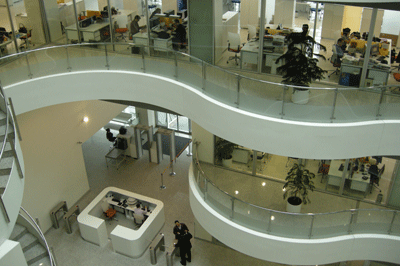
Istanbul Dairy: April 18, 2011 (Part 2)
We had arranged to meet outside the house the following morning at 10:15. Looking out the window of my room, I saw that the rain was beating down even harder than the night before.
It was as if a dark cloud was hanging over Istanbul. Our narrow street had turned into a torrential river of water cascading down. I tried to find some shelter outside and saw that the neighbourhood cats were in the same predicament.
It is said that Turks love cats and I can affirm they are all over the place; greatly outnumbering dogs. If, in Yerevan, you generally spot cats, rummaging around garbage cans, in Istanbul you can find them everywhere– in restaurants, hotels and building courtyards.
One my colleagues from Yerevan quickly nicknamed our street “Kadvashen” in their honor. I guess, by extension, we should be called “Kadvashentsiner”.
 Sousaye, our escort, took us to Istiklal Street, a mere 200 meters away. I had been told back in Yerevan that Istiklal was active day and night; a constant flow of people. It turned out to be true. People were scurrying about at a fast clip. At first I thought it was due to the pouring rain. Then I realized people rush around like ants on a mission in all large cities.
Sousaye, our escort, took us to Istiklal Street, a mere 200 meters away. I had been told back in Yerevan that Istiklal was active day and night; a constant flow of people. It turned out to be true. People were scurrying about at a fast clip. At first I thought it was due to the pouring rain. Then I realized people rush around like ants on a mission in all large cities.
But at that moment, my main concern was to stay dry. Even my umbrella was no defense against the downpour and crazy wind that drove the rain up, down and sideways.
The narrow streets that crossed Istiklal were no refugee either. At any moment a guy on a motorbike would rush through, spraying unsuspecting pedestrians with muddy rainwater.
We headed up to Taksim Square. My eye caught a small red tram filled with people on their way back down Istiklal towards Beyoglu and Galata. I was reminded of a scene from Henri Verneuil’s film “Mayrik” showing a tram travelling down a cobblestone street.
In Yerevan, the main means of transpiration is the minivan. Here in Istanbul, it’s the bus, metro and taxis. Let me add that Istanbul drivers are just as “daring” as those in Yerevan. Maybe it’s our hot eastern blood.
People were waiting for us at the Istanbul Kultur University; where the GPOT office is located.
Dr. Mensur Akgün is the director of the GPOT, which operates under the auspices of the University. Having been told that he was a classmate of Turkey’s Foreign Minister Davutoglu and holds just as much sway when it comes to Turkish foreign policy; I followed his responses to questions posed by our group with particular attention. They were classic examples of Turkish diplomacy.
His comments regarding Armenia seemed sincere however. For Turkey, Armenia is a small fish – it’s that simple. Maybe I’ll have the occasion to reflect on Dr. Akgün’s views again.
 Our next stop for the day was the editorial offices of the Turkish daily Zaman. The building could house several Armenian TV stations and a score of newspaper offices; it’s huge.
Our next stop for the day was the editorial offices of the Turkish daily Zaman. The building could house several Armenian TV stations and a score of newspaper offices; it’s huge.
With its own printing plant and related publications, Zaman is a powerhouse not just in Turkey but the entire region.
Foreign Desk Editor Celil Sagır proudly told me that the paper would soon hit a one million print run; a first in Turkish press history. And the paper itself was founded only 25 years ago in 1986.
But here isn’t the place to get bogged down in details about the press in turkey and Zaman in particular.
I am sure I’ll return to Zaman at a later date, especially since Celil Sagır came across as an educated and pleasant guy given his answers and hospitality.
By the time we left the Zaman building, the rain had let up quite a bit. But the sky remained overcast and that damn wind was still blowing.
It was time to return home, get a bite to eat, and hunker down in front of the computer.
They were waiting for my reports back in Yerevan.
 Videos
Videos Photos
Photos




Write a comment